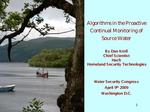Description
Significant advances have been made in methods that can be employed for monitoring occurrence of protozoan parasites in water. Issues still remain with respect to whether the selected sample volumes are adequate and whether IMS kits are able to analyze naturally acquired sample concentrates in their entirety. The cross-reactivity of monoclonal antibodies used in IMS kits also raises an issue of potentially enriching the final concentrate with both target organisms as well as organisms that share similar epitopes as the target organisms. This presents the danger of misidentification using conventional immunofluorescence assays and the need for secondary confirmation becomes imperative. Presently this is achieved by DAPI staining was well as Nomarski-Differential Interference contrast (DIC) microscopy. Unfortunately, DAPI is a non-specific nuclear stain, whereas Nomarski-DIC requires high levels of microscopic and parasitological experience. Most amplification procedures rely on the polymerase chain reaction (PCR), which can be inhibited by the presence of environmental contaminants, which necessitates the use of IMS. This means that the IMS (immunological assay) would be the sensitivity limiting factor in the detection procedure and in turn the benefits of PCR may be no greater than detection using IFA. Despite this, molecular procedures, especially those enabling characterization of recovered organisms into their various genotypes are likely to play an important role in understanding the epidemiology of organisms recovered from water samples and development of strategic measures for watershed protection. Includes 26 references.
Product Details
- Edition:
- Vol. – No.
- Published:
- 01/01/1999
- File Size:
- 1 file , 210 KB
- Note:
- This product is unavailable in Ukraine, Russia, Belarus





